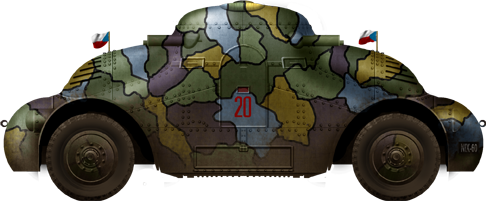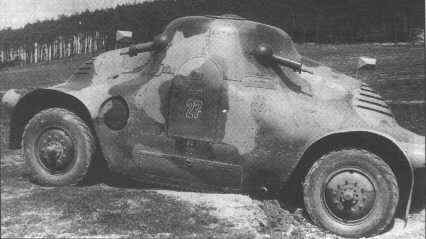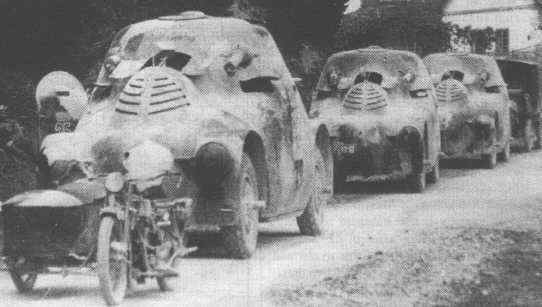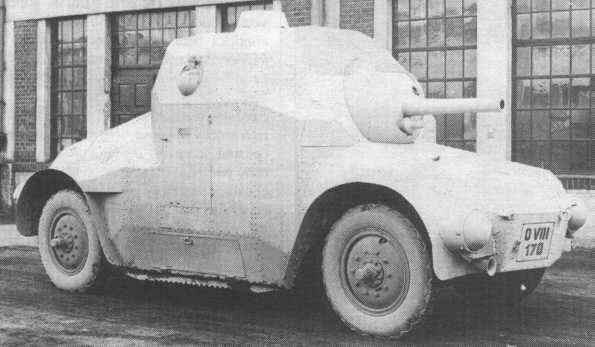Development of the OA vz. 23
 The PA-II ("Armored Car II") was developed by Škoda, which capitalized on the experience gained on the previous semi-experimental PA-I, in 1922-23. But, this time, the Chief Engineer\'s choice was to provide the hull with an all-around streamlined armor bodywork. This quickly earned the new vehicle the nickname of "Želva" (Tortoise), never officialized. Instead, the Army designation was Obrněný Automobil model 1923 (OA vz.23). By the fall of 1923, the blueprints were ready and submitted to the the Army. 12 vehicles were ordered, to be delivered until December 1924 and mid-1925.
The PA-II ("Armored Car II") was developed by Škoda, which capitalized on the experience gained on the previous semi-experimental PA-I, in 1922-23. But, this time, the Chief Engineer\'s choice was to provide the hull with an all-around streamlined armor bodywork. This quickly earned the new vehicle the nickname of "Želva" (Tortoise), never officialized. Instead, the Army designation was Obrněný Automobil model 1923 (OA vz.23). By the fall of 1923, the blueprints were ready and submitted to the the Army. 12 vehicles were ordered, to be delivered until December 1924 and mid-1925.
Design of the "turtle"
Although the chassis was roughly identical to the experimental PA-I, the armored body was entirely new. It had unusually curved shapes, which seemed like an Art Deco essay, but were dictated by cold considerations of maximal protection effectiveness. Instead of casting the armor, only possible for large thicknesses, the plates were hammer-shaped, 5.5 mm (0.22 in) at the thickest. This was the same process by which the bodywork artists tailored cars for the rich and famous, these skills being present at Skoda as well, descended from a long tradition going back to the master craftsmen shaping knight armor by hand. All the parts were then riveted on a steel frame built above the chassis. The latter was perfectly symmetrical, with the double drive pioneered by the PA-I. The two drivers sat in centrally at either end, and had a twin-fold armored shutter and lateral armored shutters. Access was granted by central doors in the fighting compartment. There was also a provision for four machine guns. These were of the heavy liquid-cooled Schwarzlose MG.08 type, having 6250 rounds. They were mounted in ball-mounts, having some limited elevation/depression and traverse. They were served by the two gunners. A small cupola could be opened for the commander to direct fire from the roof. The engine was a Skoda, 4 cylinder, 9730 cc, 70 hp, placed in the center, right below the fighting compartment. It gave a maximum top speed, on road, of 70 km/h (44 mph), which was acceptable given the weight of the vehicle. Field performance showed it could ford 1.50 m deep of water, a 30 cm vertical obstacle or cross a trench 45 cm wide. The suspensions and tires were not ideal for cross-country rides, but at least there was a four wheel drive. The chassis had the serial numbers from NIX58 to NIX69.The Škoda PA-II "Dělový" artillery support vehicle
An up-armed prototype, the PA-II dělový (cannon) was armed with a 75 mm (2.95 in) delom Škoda L28 gun. At least one prototype was built in 1927, as shown in some rare photos. It was based on the same chassis, but featured a bulkier hull. The gun was mounted on the front-left hand side of the fighting compartment, while the driver was located to its right. Two ball-mouunted machine guns were also mounted on each side, and a small cupola at the top for the commander. Its characteristics were a crew of 4, 9.4 t, 6.06 m (19.9 ft) in length, 2.81 m (9.22 ft) in height, and 45 km/h (28 mph) top speed.The Škoda PA-II in service
When the vehicles were presented to the Czechoslovak army, which had ordered them in 1925, they were tested and eventually refused. They were bulky, heavy and not very agile, with poor ground clearance that forbade off-road rides and an internal fighting compartment that was too cramped. Instead, Skoda sold three of them to Vienna\'s police forces in 1927, as a compensation for a batch of OA vz.27 that were never delivered. The remaining nine were purchased by the Czech police ten years after, actively showcased in parades and exercises in the meantime. Another Skoda armored car, the Obrněný Automobil vz. 27, was instead chosen by the Army for active service. The Austrian vehicles saw action in the repression of the Nazi coup in 1934. At some point, two vehicles were incorporated in the Austrian-Croatian border police force, notably the 16th Company, when the riots erupted. A number of Czech vehicles were seized and incorporated into the Wehrmacht after 1939, modified to use a radio, as radio relay vehicles. Their operational capabilities were rather limited, but they seem to have been used until 1945.Links about the Škoda PA-II "Želva"
The Škoda PA-II "Želva" on Tanks in WW2The Želva on Aviarmor.net (in Russian)
Škoda PA-II "Želva" specifications |
|
| Dimensions | 6 x 2.17 x 2.05 m (19.7x7.12x6.73 ft) |
| Total weight, battle ready | 7.36 tons |
| Crew | 5 (commander, 2 drivers, 2 machine-gunners) |
| Propulsion | Praga RHP 6-cyl 4v 9,730 cu cm, 55 hp @1500 rpm |
| Speed | 70 km/h (28 mph) |
| Range | 250 km (155 mi) |
| Armament | 4x Schwarzlose vz.07/24 7.92 mm (0.31 in) LMGs |
| Armor | 3-5.5 mm (0.12-0.22 in) |
| Total production | 12 |

PA-II, Milovice assault vehicles regiment, 1932.
.png)
Panzerspahwagen Skoda PA-II(Fu) 4 räd, French campaign, May 1940.
Škoda PA-II "Želva" Gallery



.jpg)

WW2 Tanks




























WW2 tanks posters

All Tiger tanks liveries.

Panther liveries and variants

WW2 Armour - All tanks











Tanks aces and single tanks series

Find more there

Museums, Movies, Books & Games
The Tanks and Armor in pop culture
Tanks and armored vehicles in general are only really grasped when seen first person: The mass, the scale, it's all there. Explore also the way tanks were covered in the movie industry, in books and in video games.Movies:
Best tanks movie on warhistoryonline.com
On imdb.com
On bestsimilar.com/
miltours.com
liveabout.com/
watchmojo.com
Video Games:
pcgamesn.com
historyhit.com
levvvel.com
vg247.com/best-tank-games
mmobomb.com/
alienwarearena.com

